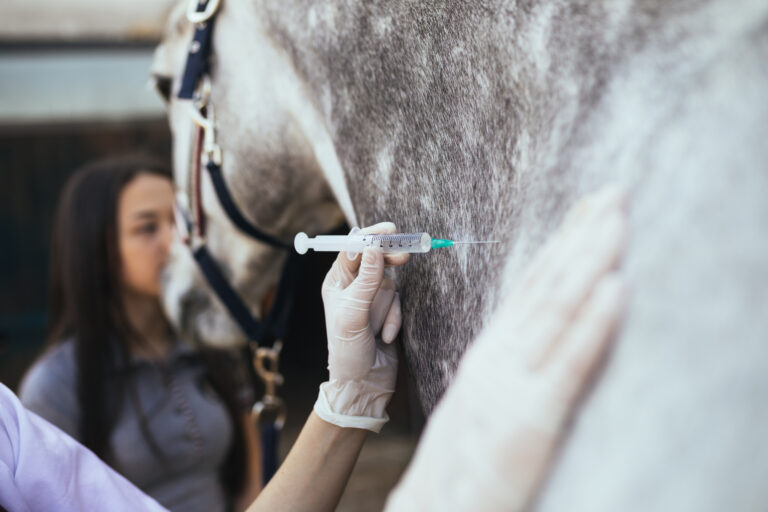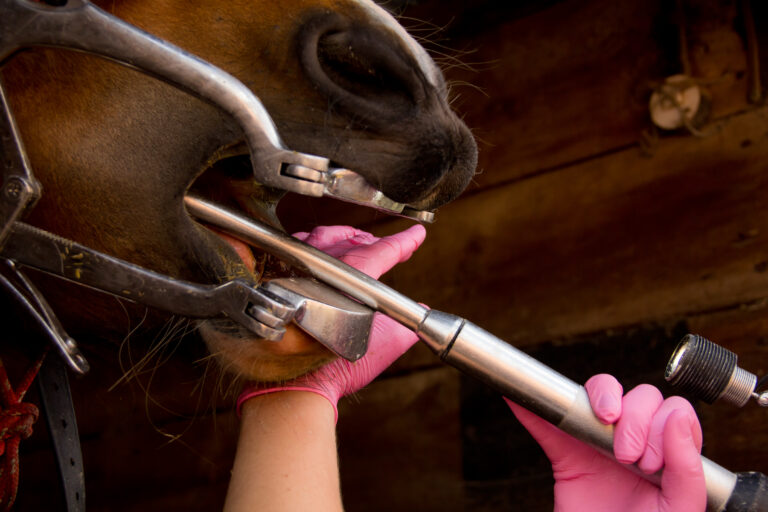
While there are many methods of suppressing estrus in mares to eliminate unwanted behaviors, Holly Clement, MS, DVM, clinical associate professor at Utah State University’s College of Veterinary Medicine, said an ideal protocol would be:
- Safe for both the mare and handler.
- Minimally invasive.
- Efficacious.
- Reversible.
- Convenient.
- Cost-effective.
Thus, Clement recommended inhibiting luteolysis when suppressing estrus for behavioral reasons.
Flux of Progesterone During Mare’s Cycle
During a “Burst” session at the 2024 AAEP Convention, Clement briefly reviewed the flux of progesterone during the mare’s cycle. She reminded attendees that during estrus, serum progesterone concentrations are very low. After the mare ovulates, the corpus luteum (CL) produces progesterone (during diestrus). In the absence of maternal recognition of pregnancy, the CL is lysed around Day 16 by prostaglandin F2-alpha (PGF2a) produced by the endometrium, progesterone levels drop, and the mare goes back into estrus.
Estrus Suppression Protocol 1
“If we administer exogenous oxytocin in the early to mid-phase of the diestrus portion of the cycle approaching Day 10 post-ovulation, this has an effect where it inhibits upregulation of COX-2, which is an essential enzyme for PGF2a synthesis,” said Clement. “The end result is a prolonged function of that CL.”
On average, the CL will stay active for about 60 days after oxytocin administration, with a range of 35-90 days.
“If the oxytocin is administered after Day 10 post-ovulation, there is an effect where it stimulates PGF2a and the protocol won’t work … we’ll get luteolysis instead,” warned Clement.
Ideally, practitioners should administer oxytocin when serum progesterone exceeds 1 ng/mL, when a functional CL is present. There are two main protocols for achieving this. The first involves administering 60 U aqueous oxytocin intramuscularly once daily on Days 7-14 post-ovulation.
“But you need to know the day of ovulation for this protocol! There are eight injections total needed, and this protocol is about 70% effective in suppressing estrus for 60 days,” Clement said.
Estrus Suppression Protocol 2
A second protocol involves administering 60 U aqueous oxytocin intramuscularly once daily for 29 consecutive days. Veterinarians can perform this protocol without knowing the day of ovulation, and it is 78% effective in suppressing estrus for 56-80 days.
These protocols are hitting on many parameters, but they are not convenient, Clement admitted during her presentation.
Estrus Suppression Protocol in Development
One protocol in development uses extended-release oxytocin. Clement’s data showed that 2,400 U oxytocin administered intramuscularly once on Days 7 and 10 had a 75% efficacy rate compared to the nontreated controls.
Trying to further refine the technique, Clement administered 4,800 U oxytocin once on Day 10 only. That protocol was 63% effective, and prolonged CL function lasted 64-76 days.
Clement is hoping this latter protocol will be available soon for clinical use, because it is the most convenient, hitting all the parameters of a good estrus suppression protocol.
Related Reading
- Emergency Hormones for Embryo Transfer Recipient Mares
- How To Synchronize Recipient Mares on the Farm
- Bringing a Mare Back After Pregnancy Loss
Stay in the know! Sign up for EquiManagement’s FREE weekly newsletters to get the latest equine research, disease alerts, and vet practice updates delivered straight to your inbox.

![[Aggregator] Downloaded image for imported item #18374](https://s3.amazonaws.com/wp-s3-equimanagement.com/wp-content/uploads/2025/09/30140012/EDCC-Unbranded-28-scaled-1-768x512.jpeg)


